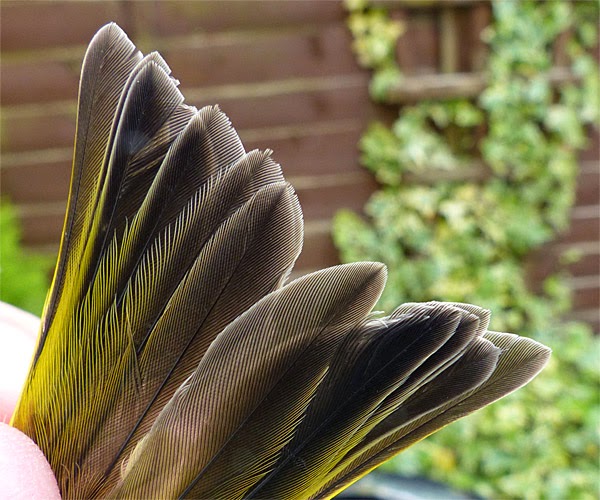Over the last couple of weeks I have seen increasing numbers of birds returning to the garden feeders, but I just hadn’t had the time to put a net up. The most numerous species are Blue and Great Tits, and so not everyones cup of tea, but I don’t mind ringing them. If I want to put a net up in the garden to try for other species, then the tits are just a by-product. But its not all bad as it is possible to build up some good longevity data through retrapping the same birds. In fact only this week I heard back from BTO HQ, that a Blue Tit that I had ringed on 31st December 2008 was killed by a neighbours cat on 9th May 2014, 5 years and 129 days since ringing. This is not a record by any means, that stands at 9 years, 9 months and 2 days, but it is a good age for a species that on average survives for just 3 years (according to BTO facts). Interestingly this bird had not been re-trapped since its original ringing date, but was evidently still in the area.
 |
| Juvenile Greenfinch - note streaking on breast |
 |
| Juvenile Greenfinch Wing - note the brown fringed greater coverts and pointed primary converts |
This session required a 5am start which was not idea since I had stayed up late to watch the England vs Italy match. Given the result I wished I hadn’t but we make these mistakes in life, when it comes to watching England playing football I never seem to learn! It was a steady morning that resulted in 30 birds from only four nets. Unlike my garden, only two tits were caught, one blue and one great. The most numerous species was Common Whitethroat, with nine birds ringed, followed by Chiffchaff, with eight birds ringed.
 |
| Juvenile Chiffchaff - the plumage is very fresh and fluffy; a yellow gape is still obvious |
Two of the whitethroats were retraps, one from 2nd June 2012 and one from 1st May 2013, four were adults and five were juveniles. This was great training for Chris who was able to compare the differences between adult and juvenile whitethroats in prep for the autumn at Titchfield Haven.
 |
| Adult Whitethroat - note pale iris |
 |
| Juvenile Whitethroat - note dark iris - when ringing whitethroats in the autumn always check the eye as the colour of the iris will give you a clear clue to the birds age |

No comments:
Post a Comment